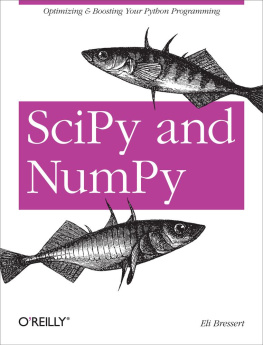Eli Bressert [Eli Bressert] - SciPy and NumPy
Here you can read online Eli Bressert [Eli Bressert] - SciPy and NumPy full text of the book (entire story) in english for free. Download pdf and epub, get meaning, cover and reviews about this ebook. year: 2012, publisher: O’Reilly Media, genre: Home and family. Description of the work, (preface) as well as reviews are available. Best literature library LitArk.com created for fans of good reading and offers a wide selection of genres:
Romance novel
Science fiction
Adventure
Detective
Science
History
Home and family
Prose
Art
Politics
Computer
Non-fiction
Religion
Business
Children
Humor
Choose a favorite category and find really read worthwhile books. Enjoy immersion in the world of imagination, feel the emotions of the characters or learn something new for yourself, make an fascinating discovery.
- Book:SciPy and NumPy
- Author:
- Publisher:O’Reilly Media
- Genre:
- Year:2012
- Rating:3 / 5
- Favourites:Add to favourites
- Your mark:
SciPy and NumPy: summary, description and annotation
We offer to read an annotation, description, summary or preface (depends on what the author of the book "SciPy and NumPy" wrote himself). If you haven't found the necessary information about the book — write in the comments, we will try to find it.
Are you new to SciPy and NumPy? Do you want to learn it quickly and easily through examples and a concise introduction? Then this is the book for you. Youll cut through the complexity of online documentation and discover how easily you can get up to speed with these Python libraries.
Ideal for data analysts and scientists in any field, this overview shows you how to use NumPy for numerical processing, including array indexing, math operations, and loading and saving data. Youll learn how SciPy helps you work with advanced mathematical functions such as optimization, interpolation, integration, clustering, statistics, and other tools that take scientific programming to a whole new level.
The new edition is now available, fully revised and updated in June 2013.
- Learn the capabilities of NumPy arrays, element-by-element operations, and core mathematical operations
- Solve minimization problems quickly with SciPys optimization package
- Use SciPy functions for interpolation, from simple univariate to complex multivariate cases
- Apply a variety of SciPy statistical tools such as distributions and functions
- Learn SciPys spatial and cluster analysis classes
- Save operation time and memory usage with sparse matrices
**
Eli Bressert [Eli Bressert]: author's other books
Who wrote SciPy and NumPy? Find out the surname, the name of the author of the book and a list of all author's works by series.

![Eli Bressert [Eli Bressert] SciPy and NumPy](/uploads/posts/book/119331/thumbs/eli-bressert-eli-bressert-scipy-and-numpy.jpg)






![Ivan Idris [Ivan Idris] - NumPy: Beginner’s Guide - Third Edition](/uploads/posts/book/119330/thumbs/ivan-idris-ivan-idris-numpy-beginner-s-guide.jpg)
![Ivan Idris [Ivan Idris] - NumPy Cookbook - Second Edition](/uploads/posts/book/119328/thumbs/ivan-idris-ivan-idris-numpy-cookbook-second.jpg)



